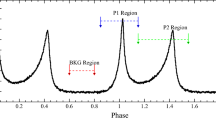Abstract
New results of UBV JHKLM photometry of the symbiotic Mira V407 Cyg performed in 1998–2002 are reported. In 2002, these observations were supplemented with RI observations and a search for rapid variability in the V band. The hot component of V407 Cyg experienced a strong flare in 1998, which was the second in the history of photometric observations of this star; this flare is still continuing. During the flare, the spectral energy distribution of the hot component can be approximated by blackbody radiation with a temperature of ∼7200 K. At the maximum brightness, the bolometric flux from the hot component did not exceed 3% of the Mira's mean bolometric flux, while its bolometric luminosity was ∼400L⊙. Appreciable variations of the star's BV brightness \((\tilde0\mathop m\limits_. 7)\) on a timescale of several days have been observed. These variations are not correlated with variations of B-V. Flickering on a timescale of several minutes with an amplitude of \(\tilde0\mathop m\limits_. 2\) has been detected in the V band. The observations suggest that the hot component can be in three qualitatively different states. In a model with a rapidly rotating white dwarf, these states can be associated with (i) the quiescent state of the white dwarf (with a very low accretion rate), (ii) an ejection state, and (iii) an accretion state. The Mira pulsation period P is \( \approx 762\mathop d\limits_. 9\), with its infrared maximum occurring ∼0.15P after the visual maximum. A “step” is observed on the ascending branch of the Mira infrared light curves. In 1998, the gradual increase of the mean K brightness of the Mira that had been observed since 1984 was interrupted by an unusually deep minimum, after which the mean level of the K brightness considerably decreased.
Similar content being viewed by others
References
C. Hoffmeister, Veroff. Sternw. Sonnebrerg. 1, 295 (1949).
L. Meinunger, Mitt. Veranderl. Sterne. 87, 111 (1966).
E. A. Kolotilov, Y. Munari, A. A. Popova, et al., Pis'ma Astron. Zh. 24, 526 (1998) [Astron. Lett. 24, 451 (1998)].
K. M. Merrill and C. G. Burwell, Astrophys. J. 112, 72 (1950).
G. Welin, Astron. Astrophys., Suppl. Ser. 9, 183 (1973).
V. F. Esipov, O. G. Taranova, and B. F. Yudin, Astrofizika 29, 285 (1986).
U. Munari and T. Zwitter, Astron. Astrophys. 383, 188 (2002).
B. F. Yudin, Astron. Zh. 76, 198 (1999) [Astron. Rep. 43, 167 (1999)].
A. U. Landolt, Publ. Astron. Soc. Pac. 87, 379 (1975).
G. W. Lockwood and R. F. Wing, Astrophys. J. 169, 63 (1971).
A. E. Nadzhip, A. M. Tatarnikova, V. I. Shenavrin, et al., Pis'ma Astron. Zh. 27, 376 (1999).
P. A. Whitelock, New Astron. Rev. 43, 437 (1999).
U. Munari, R. Margoni, and R. Stagni, Mon. Not. R. Astron. Soc. 242, 653 (1990).
J. A. Mattei and J. Allen, J. R. Astron. Soc. Can. 73, 173 (1979).
L. A. Willson, P. Garnavich, and J. A. Mattei, Inform. Bull. Var. Stars, No. 1961 (1981).
P. W. Merrill, Astrophys. J. 81, 312 (1935).
J. Mikolajewska, P. L. Selvelli, and M. Hack, Astron. Astrophys. 198, 150 (1988).
A. A. Boyarchuk, Astron. Zh. 44, 1016 (1967).
B. F. Yudin, Astrophys. Space Sci. 135, 143 (1987).
J. L. Sokoloski, L. Bildsten, and W. C. G. Ho, Mon. Not. R. Astron. Soc. 326, 553 (2001).
T. Tomov, D. Kolev, U. Munari, and A. Antov, Mon. Not. R. Astron. Soc. 278, 542 (1996).
M. Mikolajewski, T. Tomov, A. Dapergolas, and Y. Bellas-Veldis, in Cataclysmic Variables and Related Objects, Ed. by A. Evans and J. H. Wood (Kluwer, Dordrecht, 1996), p. 341.
J. L. Sokoloski and L. Bildsten, Astrophys. J. 517, 919 (1999).
A. P. Ipatov, O. G. Taranova, and B. F. Yudin, Astron. Astrophys. 135, 325 (1984).
E. A. Olivier, P. Whitelock, and F. Marang, Mon. Not. R. Astron. Soc. 326, 490 (2001).
A. M. Tatarnikova, P. M. Marrese, U. Munari, et al., Pis'ma Astron. Zh. (in press).
I. J. Sackmann and A. I. Boothroyd, Astrophys. J. 392, L71 (1992).
Author information
Authors and Affiliations
Additional information
__________
Translated from Astronomicheski\(\overset{\lower0.5em\hbox{$\smash{\scriptscriptstyle\smile}$}}{l} \) Zhurnal, Vol. 80, No. 9, 2003, pp. 845–856.
Original Russian Text Copyright © 2003 by Kolotilov, Shenavrin, Shugarov, Yudin.
Rights and permissions
About this article
Cite this article
Kolotilov, E.A., Shenavrin, V.I., Shugarov, S.Y. et al. UBVJHKLM photometry of the symbiotic Mira V407 Cyg in 1998–2002. Astron. Rep. 47, 777–788 (2003). https://doi.org/10.1134/1.1611218
Received:
Accepted:
Issue Date:
DOI: https://doi.org/10.1134/1.1611218




